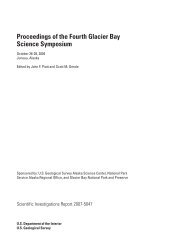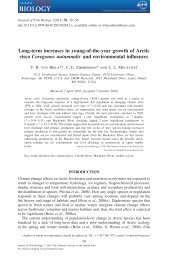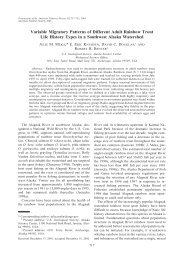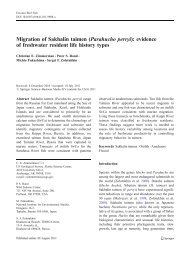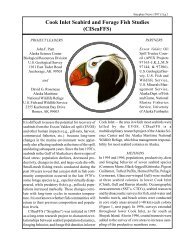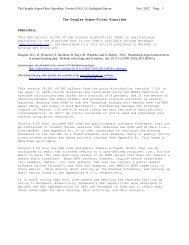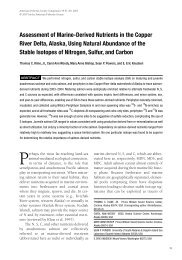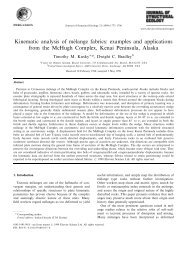Mexican native trouts: a review of their history and ... - Webspace
Mexican native trouts: a review of their history and ... - Webspace
Mexican native trouts: a review of their history and ... - Webspace
You also want an ePaper? Increase the reach of your titles
YUMPU automatically turns print PDFs into web optimized ePapers that Google loves.
310<br />
prepared a pre-investment analysis for the U.S.<br />
Agency for International Development (Dedina et al.,<br />
1998) that chronicled various conservation initiatives<br />
in the Sierra Madre Occidental. That report recommended<br />
the establishment <strong>of</strong> a ríos Ajos-Bavispe<br />
National Forest <strong>and</strong> Wildlife Refuge in the upper Río<br />
Yaqui basin in northeastern Sonora as an “anchor”<br />
site for <strong>their</strong> conservation activities. The 184,770<br />
ha refuge encompasses several “sky isl<strong>and</strong>” habitats,<br />
including Sierra El Tigre <strong>and</strong> Sierra Huachinera, with<br />
at least the latter potentially including <strong>native</strong> trout<br />
habitats. The few existing protected areas in our<br />
study area include the small Cascada de Basaseachi<br />
National Park, northwest <strong>of</strong> Chihuahua City in the<br />
upper Río Mayo (Río C<strong>and</strong>ameña) basin, established<br />
for its natural wonder <strong>of</strong> one <strong>of</strong> the highest waterfalls<br />
in the world. Proposed protected areas include<br />
Sierra San Luis, a “sky-isl<strong>and</strong>” site in northeastern<br />
Sonora; Mesa del Campanero-Arroyo el Reparo, an<br />
ecological transition zone in southeastern Sonora;<br />
Barrancas del Cobre-Sinforosa Canyon Biosphere<br />
Reserve, in the upper Río Fuerte drainage; <strong>and</strong> Las<br />
Bufas, a high-elevation old-growth forest in western<br />
Durango. Native <strong>trouts</strong> occur, or are likely to occur,<br />
in Basaseachi, Barrancas de Cobre-Sin<strong>of</strong>orosa <strong>and</strong><br />
Las Bufas, <strong>and</strong> habitat for them may exist in the<br />
other reserves, but trout habitat was not among the<br />
reason for protected status proposals for any <strong>of</strong> these<br />
cases. Recently, however, Mexico’s federal Commission<br />
for Biodiversity (CONABIO) published its list <strong>of</strong><br />
priority hydrologic regions for biodiversity conservation<br />
(Arriaga Cabrera et al., 2000). Included here are a<br />
number <strong>of</strong> large regions that are clearly relevant for<br />
<strong>native</strong> trout conservation: 16 (Río Yaqui – Cascada<br />
Basaseachi), 17 (Río Mayo), 18 (Upper Río Fuerte),<br />
20 (Upper ríos Culicán <strong>and</strong> Humaya), 21 (Upper ríos<br />
San Lorenzo-Piaxtla), 22 (Río Baluarte), 39 (Upper<br />
Río Conchos). Most <strong>of</strong> these regions with <strong>native</strong> <strong>trouts</strong><br />
score high on many factors used to rank <strong>their</strong> priorities<br />
for conservation-related programs. This document is<br />
designed to serve as a management <strong>and</strong> conservation<br />
planning tool for government at all levels in México,<br />
<strong>and</strong> is definitely being used by at least CONABIO<br />
to determine the focus <strong>of</strong> funding for biodiversity<br />
inventories <strong>and</strong> research. Our own work was in<br />
part supported by CONABIO (see Acknowledgments)<br />
under this prioritization scheme. Similarly, at an international<br />
level, areas 61 <strong>and</strong> 62 <strong>of</strong> the World Wildlife<br />
Fund’s recent publication on conservation priority for<br />
freshwater ecoregions <strong>of</strong> North America includes all<br />
mainl<strong>and</strong> basins harboring <strong>native</strong> <strong>Mexican</strong> <strong>trouts</strong> in<br />
priority class 2 (<strong>of</strong> 5, with 1 highest priority) (Abell<br />
et al., 2000). So, although existing <strong>and</strong> proposed<br />
protected areas appear unlikely to contribute in significant<br />
ways to <strong>native</strong> trout conservation, the relevant<br />
high-level planning needed to prioritize conservation<br />
actions is now in place <strong>and</strong> being implemented.<br />
Habitat alteration<br />
Our observations lead us to conclude that primary<br />
causes <strong>of</strong> trout habitat decline are related to nonpoint<br />
alteration <strong>of</strong> hydrological regimes <strong>and</strong> water<br />
quality <strong>and</strong> quantity. Despite important improvements<br />
in road design <strong>and</strong> maintenance, this alteration<br />
continues despite important improvements in<br />
road design <strong>and</strong> maintenance, through proliferation<br />
<strong>of</strong> sawmills, deregulation, forestry law enforcement<br />
issues, <strong>and</strong> economic pressure to log small material<br />
<strong>and</strong> to exploit remote locations. Alteration also<br />
continues due to ranching practices through concentration<br />
<strong>of</strong> livestock in pastures for long periods, resulting<br />
in lack <strong>of</strong> proper fallowing <strong>and</strong> maintenance <strong>of</strong> stream<br />
vegetation in early successional stages. Risk <strong>of</strong> intense<br />
disturbance is increased by diminished water-holding<br />
capacity <strong>of</strong> soils, <strong>and</strong> increased brush cover that<br />
fuels high-intensity fires. The end result is the highly<br />
eroded, silt-laden <strong>and</strong> exposed streambeds that we find<br />
so prevalent in the region.<br />
General recommendations<br />
Some recommendations for future conservation <strong>and</strong><br />
management <strong>of</strong> the Baja California rainbow trout<br />
have been previously published (Ruiz-Campos, 1993;<br />
Ruiz-Campos <strong>and</strong> Pister, 1995), <strong>and</strong> are largely<br />
applicable to other areas in the range <strong>of</strong> <strong>Mexican</strong><br />
mainl<strong>and</strong> <strong>native</strong> <strong>trouts</strong>. Protection <strong>of</strong> key habitats is<br />
important, together with prohibition or strict control<br />
<strong>of</strong> introductions <strong>of</strong> non-<strong>native</strong> species. Most importantly,<br />
however, <strong>and</strong> encompassing <strong>and</strong> affecting<br />
aspects <strong>of</strong> the first two themes, implementation <strong>of</strong><br />
sustainable management <strong>and</strong> preservation <strong>of</strong> <strong>native</strong><br />
<strong>Mexican</strong> <strong>trouts</strong> clearly requires holistic watershedbased<br />
conservation <strong>and</strong> management plans that are<br />
developed in close coordination with local residents,<br />
<strong>and</strong> tightly integrated into the local <strong>and</strong> global socioeconomic<br />
contexts.<br />
Priority habitats for conservation are found in<br />
the upper tributaries <strong>of</strong> all drainages in our study<br />
area. As obvious from Figure 1, all collections <strong>of</strong><br />
<strong>Mexican</strong> trout have been in, or very near, extreme<br />
headwaters. These headwaters are critical refugia for




